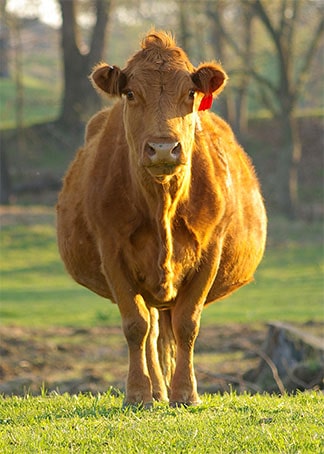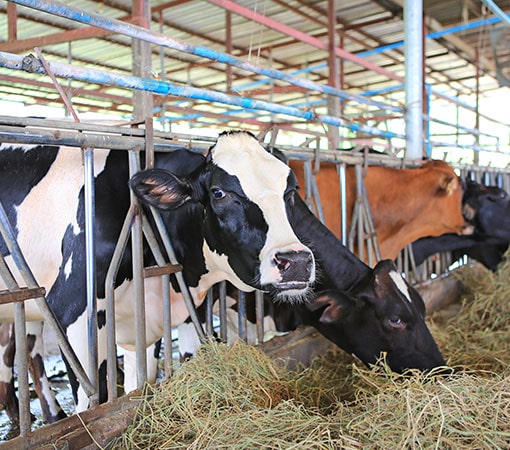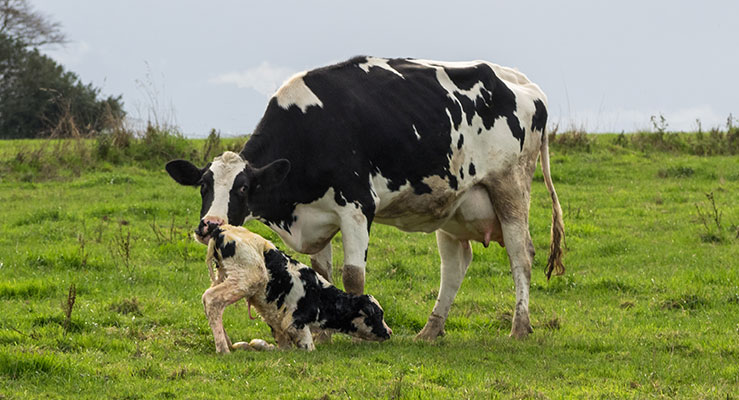- What is the Normal Cow Gestation Duration?
- At What Age Is It Safe to First Breed Young Cows?
- How to Tell When a Cow is Pregnant?
- How Long After a Cow Gives Birth can She Get Pregnant Again?
- Gestation Stages
- How Many Calves Can a Cow Deliver at Once?
- Cow Nutrition during Gestation
- Cow Labor
- Calving Problems
- Final Thoughts
Interested in cow gestation? Read this complete guide on everything you need to know about cow gestation (length, stages, problems, and more).
Understanding your cows’ gestation will contribute immensely to building your herd. As a farmer, you will be able to monitor the reproductive status and health of your cows by keeping records of the pregnancies. In this article, we are going to cover everything you need to know about cow gestation, so when the due date of your cattle comes, to know exactly how it will happen and what to do.
What is the Normal Cow Gestation Duration?
How long a cow’s pregnancy will last depends on the breed and age of the dam as well as the sex of the calf. In most cases, a normal cow’s gestation duration is approximately 283 days from contact with the bull. However, this period will frequently fluctuate from 279 to 287 days.
If more than 287 days pass and your cow still hasn't delivered the calf, you should seek the help of a veterinarian.
Kindly note that if a cow is carrying a heifer calf, then the gestation period tends to be shorter compared to another expecting to deliver a bull. Also, mature cows have a longer gestation duration compared to first-calf females. You can calculate when to expect your cow will deliver by adding 283 days from the day she was bred.
To make this very easy for you, we have created a gestation calculator for cows that will do exactly this for you. All you have to do is select the date the cow was bred and the app will do the predictions for you. More exactly, it will give you an estimated due date using the general average of 283 days, as well as a data range based on the possible variation.
At What Age Is It Safe to First Breed Young Cows?
Before we go any further, allow us to clarify one thing. A heifer is a female that is yet to have its first calf. After giving birth and is now having her second calf, the female becomes mature and is now known as a cow. Knowing when a heifer is ready to be first bred is very important. This is because it will help you plan your breeding operations in advance.
Most heifers start to show signs of heat when they are 9 months old. This however doesn’t mean that at this point they are ready to be bred. It’s only when they have fully developed that they can take on carrying a calf. It is recommended that you wait till a heifer reaches 13 to 15 months before they can be bred. At this age, their pelvic area will be grown and can sustain their bodies throughout gestation.
How to Tell When a Cow is Pregnant?

When the gestation evidence becomes obvious, the cow will already be in an advanced stage of the pregnancy. Therefore, you need to know how to tell if your cattle are pregnant as early as possible.
There are several methods and ways that are typically used to determine whether a cow is pregnant. These include:
Non-Return To The Heat Cycle (Estrous)
Estrous (or estrous cycle) is what most farmers commonly refer to as heat in cows. These cycles happen at about every 21 days and give cows and heifers repeated occasions to become pregnant. This average might vary from one cow to another and can fluctuate between 17 to 24 days. When a cow is in estrous, it becomes more receptive to a bull and is ready to mate.
If after about 3 to 4 weeks after insemination you do not see any signs that the cow gets back in heat, then this can be one of the earliest signs of pregnancy. Even though this is probably the most simple cow gestation testing method, you can’t be 100% sure. Experiments have shown that some cows exhibit signs of estrous cycles even during pregnancy. That is commonly known as "false heat."
Rectal Palpation
This is practically the easiest and most convenient method of testing pregnancy in cows. It can detect pregnancy as early as 6 weeks after insemination. Done by professional vets, this method entails checking for a pulse in the artery supplying blood to the cow’s uterus.
This is not the most elegant nor the cleanest task, but it's one of the most efficient ways to tell if your cattle are pregnant.
Ultrasound Examination
There are portable ultrasonic pregnancy detectors that reflect a beam to the uterine artery and umbilical vessel. As a result, converting sound to light display enabling one to test if a cow is pregnant or not.
Blood Test
Finding out if your cows are pregnant using a blood test is a more recent practice. It is quick, clean, relatively inexpensive, 99% accurate, and results are available in less than 14 days. Unfortunately, there aren't yet too many companies with specialized labs that execute these cattle pregnancy blood tests and you may not find one in your nearby just yet.
These four are the most common ways you can tell if a cow is pregnant. For farmers that practice livestock keeping on a small scale, you can always notice physical signs. But this will be way further in the gestation period.
The benefit of these procedures is that you can find out for sure whether your cow is pregnant before the visible signs appear. Secondly, you can accurately estimate calving dates and most importantly, detect infertility in cows.
How Long After a Cow Gives Birth can She Get Pregnant Again?
It is advisable that you let your cow rest for 2 to 3 months. The reason being, the cow’s uterus does need time to shrink after pregnancy and the estrous cycle also needs to normalize.
You may be confused when your cow gets into heat 2 or 3 weeks after calving. Even if that, in theory, means that she is ready to get pregnant again, to avoid any future health issues, you should wait a bit longer until you allow her to mate again.
The above usually occurs because the cow has endured long periods of staying out of the heat cycle and you can expect there to be irregular hormonal fluctuations. Immediately your cow returns to regular estrous cycling, you can allow her to become pregnant.
Gestation Stages
A normal cow gestation has typically the following stages of development:
1. Pregnancy within First 3 Months
Within 21 days after conception, there are high risks of miscarriages. The risk keeps on going low as we head into the first, second, and third months. By the third month, the calf is usually the size of a mouse.
2. Pregnancy within 3 to 5 Months
At this point, the structures can be felt because the fetus is too far forward in the body.
3. Pregnancy from 5 to 7 Months
To guarantee the fetus grows healthily, the cow or heifer should be fed food rich in nutrients. At this stage, the fetus is the size of a cat.
4. Pregnancy from 7 to 9 Months
Most of the fetus growth happens during this stage and the feed requirements ought to remain high. It is advisable to stop milking the cow three months before calving.
5. Calving
As the pregnancy nears its full term, the calf weighs at least 50 lbs. When the cow starts appearing uneasy, this should be warning signs of labor. You can expect the delivery to last 30 minutes to 2 hours.
How Many Calves Can a Cow Deliver at Once?
Twins are no longer a rare occurrence with cows. And there have been reports worldwide of heifers and cows giving birth to 4 and even 16 calves. In 2013, there was a story posted on BBC about a cow that gave birth to 16 calves in County Limerick in Ireland.
As much as of a blessing getting more than one calf at once is, you should be aware of the drawbacks. Twin calves of different breeds can result in infertility.
Cow Nutrition during Gestation

Make sure you supplement their food with better quality hay. If you have quality pasture, you can supplement it by adding protein pellets. It’s important to divide the herds into smaller groups to avoid having some cows eat more than others.
Other than hay, a pregnant cow will also need grain to provide her with energy. Silage can also make a great alternative to hay depending on your location.
Cow Labor
Cow labor takes place in three stages. It often lasts less than 8 hours. Knowing when to expect cow labor is important because you will be able to provide assistance where needed.
1st Stage – Preparation Stage
It takes 2 to 6 hours for the calf to rotate to an upright position. Then the uterine contractions begin. Your heifer may isolate herself from the rest of the herd and appear uneasy. The water sac will be expelled.
2nd Stage – Deliver
Takes an hour or less. The cow will lie down and the fetus will enter the birth canal. The front feet and head will come out first followed by the entire body of the calf.
3rd Stage – Cleaning
In the next 2 to 8 hours, the uterine contractions will expel the membranes from the cow’s uterus. Should you cow not pass the afterbirth, consult a vet to give you the best form of treatment.
Calving Problems
Also known as dystocia, calving difficulty isn’t an abnormal occurrence for many livestock keepers. Lack of proper heifer management and bull selection can result in calving difficulties. At times, they can occur for no apparent reason. Being able to notice calving problems as early as possible is vital in helping prevent calf death and rebreeding complications.
Having fully understood the cow labor process, should one stage take longer than usual, you should get professional help from a vet. Ensure you are examining the cow at all times during the calving process. For instance, you should check if the cervix is dilating. This will let you know whether the calf will smoothly pass through.
Secondly, confirm if the calf is alive by pinching or pulling their feet and getting a reaction. Finally, you need to examine the position of the calf. If it has not fully rotated then this should be a call for alarm and immediate assistance.
An experienced vet can diagnose calving problems and offer assistance to save the life of the calf and ensure the dam remains in perfect health. It’s good to always have the contacts of a nearby vet in case of calving emergencies.
Final Thoughts
Getting a healthy calf after every delivery is a cattle farmer’s main objective. By familiarizing yourself with all there is to know about cow gestation, you can prepare, plan, and tackle any issue that arises during the gestation and calving.
Resources:
- The Cow-Calf Manager - Link
- Reproduction 101: Basics of Breeding Cows and Heifers - Link
- Pregnant cows, timing of pregnancy, open cows, pregnancy rate - Link
- Pregnancy Diagnosis in Your Cow-Calf Herd - Link
- Pregnancy diagnosis in heifers and cows - Link
- Cow Pregnancy Stages - Link
- Estrous Cycle Learning Module - Link
- Recognizing and Handling Calving Problems - Link

